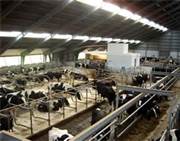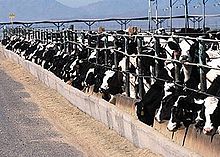Farm animals including pigs and chickens,are housed in
massive confinement buildings that resemble factory warehouses,and most of these
animals never see the outdoor until they are sent to slaughter.
In factory farms,animals do not even have enough space to move their limbs or turn around.Broiler chickens are crammed into buildings holding thousands of birds,while chickens used in egg production are confined in ”battery cage”that usually measures 144 square INCHES,often with cages stacked 3 to 5 layers high,there are usually eight or nine hens kept in each cage.The hens live like this for about two years or less, until their bodies are exhausted from the stresses of constant laying and their egg production decreases. At that point,they are shipped to slaughter to be turned into animal feed or sometimes human
food or are simply discarded. In 2003 a public outcry brought attention to a California ranch that was reported to have discarded thousands of live hens using a wood chipper; no charges were brought because, as it turned out, this is a common industry practice.
There are about 300 million laying hens in the United States; of these, some 95 percent are kept in wire battery cages, which allow each hen an average of 67 square inches of space—less than the size of a standard sheet of paper.Hens are usually kept eight or nine to a cage; long tiers of these cages are built one upon another in sheds that hold tens of thousands of birds, none of whom has enough room to raise a wing. A very horrible effect of the egg-production industry is the wholesale destruction of male chicks, who are useless to the egg industry. These chicks are not used in the meat industry either, because they have not been genetically manipulated for meat production. Male chicks are ground up in batches while still alive, suffocated in trash cans, or gassed.
More than 50 billion chickens are raised and slaughtered annually.
Only in movies do pigs spend their lives running across sprawling pastures and relaxing in the sun.
On any given day in the U.S., there are more than 65 million pigs on factory farms, and 110 million
are killed for food each year.
Mother pigs (sows)who account for almost 6 million of the pigs in the U.S.spend most of their lives in individual “gestation” crates.These crates are about 7 feet long and 2 feet wide too small to allow the animals even to turn around.After giving birth to piglets, sows are moved to “farrowing” crates, which are wide enough for them to lie down and nurse their babies but not big enough for them to turn around or build nests for their young.
Piglets are separated from their mothers when they are as young as 10 days old. Once her piglets are gone, the sow is impregnated again, and the cycle continues for three or four years before she is slaughtered. This intensive confinement produces stress- and boredom-related behavior, such as chewing on cage bars and obsessively pressing against water bottles.
After they are taken from their mothers, piglets are confined to pens until,they are separated to be raised for breeding or meat.Every year in the U.S., millions of male piglets are castrated (almost always without being given any painkillers) because consumers supposedly complain of “boar taint” in meat that comes from intact animals.In extremely crowded conditions, piglets are prone to stress-related behavior such as cannibalism and tail-biting, so farmers often chop off piglets’ tails and use pliers to break off the ends of their teeth without giving them any painkillers.For identification purposes, farmers also cut out chunks of the young animals’ ears.



